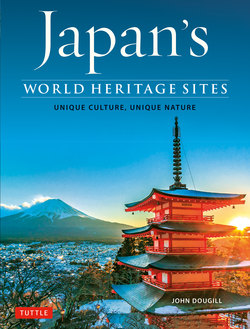Читать книгу Japan's World Heritage Sites - John Dougill - Страница 9
На сайте Литреса книга снята с продажи.
ОглавлениеThe PEACE MEMORIAL at HIROSHIMA
SOLE SURVIVOR OF THE WORLD’S FIRST NUCLEAR BLAST
THE PEACE MEMORIAL AT HIROSHIMA AT A GLANCE
REGISTRATION 1996, as a reminder of mankind’s destructive ability and as a symbol for world peace.
ACCESS 15 mins by bus or streetcar from Hiroshima JR stn.
FEATURES A domed building, only viewable from outside, with the Peace Memorial Park and Museum nearby.
PRACTICALITIES Museum 8.30–18.00/17.00 (winter). ¥50. Closed Dec 29–Jan 1. (Audio guide recommended; ¥300). The Peace Park and Museum can take up to half a day. Volunteer guide, apply 10 days in advance: (082) 843-9030 or email: taif@fureai-ch.ne.jp
INFORMATION Tourist office tel. (082) 247 6738. Written enquiries through the Hiroshima Navigator website.
DATELINE
1915—Construction
1945—Atomic bomb destroys all other buildings in the area
1950–64—Peace Memorial Park laid out
1955—Peace Memorial Museum (remodeled 1994)
On August 6, 1945, at 8.15 am, the world’s first nuclear bombing occurred. The explosion took place 1,968 feet (600 meters) above Hiroshima’s commercial center, flattening the whole district. The sole structure left standing was the skeletal remains of a building which came to be known as the Genbaku Dome (Atomic Bomb Dome). In 1966, a resolution was passed by Hiroshima City Council to preserve it in perpetuity.
Designed by a Czech architect, the brick building had a five-storey core capped by a copper-clad dome. When the bomb exploded, the main structure shattered but miraculously the iron-framed dome held in place. It’s the only building to remain from the time of the blast, and it acts as the focal point for the Peace Memorial Park and Museum which attract nearly a million and a half visitors every year.
Schoolchildren pay respects to the monument for twelve-year-old Sadako Sasaki, behind which hang hundreds of paper cranes in her memory.
In the park are monuments to those who died. There’s a burial mound with the ashes of 70,000 unidentified victims, and a cenotaph listing everyone who perished as a result of the blast at the time or later (some 200,000). There’s also a monument for the Korean victims, many of whom were conscripts. Most famously of all, there’s a memorial to twelve-year-old Sadako Sasaki, who believed that if she folded 1,000 cranes she would be cured of radiation illness.
The Peace Memorial building was designed in 1915 by a Czech architect as part of the Hiroshima Prefectural Commercial Exhibition. The only structure left standing near the epicenter of the nuclear explosion, it is widely known as the Genbaku Dome (Atomic Bomb Dome).
The Peace Memorial Museum is divided into two parts. The East Building tells the story of Hiroshima before and after the bombing. The West Building focusses on the physical effects. Some of the exhibits are heart-rending: clothing remnants, charred lunch boxes, the last words of dying children. Details of the destruction are portrayed through photos and paintings. Black rain streaks cover a white plaster wall and the stages of radiation sickness are graphically displayed. It’s a moving experience designed to reinforce the exhibition’s central message: Never again!
The Peace Bell sounds mournfully throughout the Memorial Park as visitors line up to ring it. Constructed in 1964, it bears a map of the world and an atomic symbol marks the spot where it is struck.
The East Wing of the Memorial Museum, redesigned in 2017, allows for open space to cope with the number of visitors. Interactive panels provide details about the damage done in particular areas.
The Memorial Cenotaph aligned towards the Atomic Dome bears an epitaph which translates as ‘Let all the souls here rest in peace for we shall not repeat the evil.’
Amongst the most moving of the exhibits are those that speak of personal tragedy, such as this irradiated tricycle. Nearby a watch has stopped at exactly 8.16, the time of the blast on August 6, 1945.
